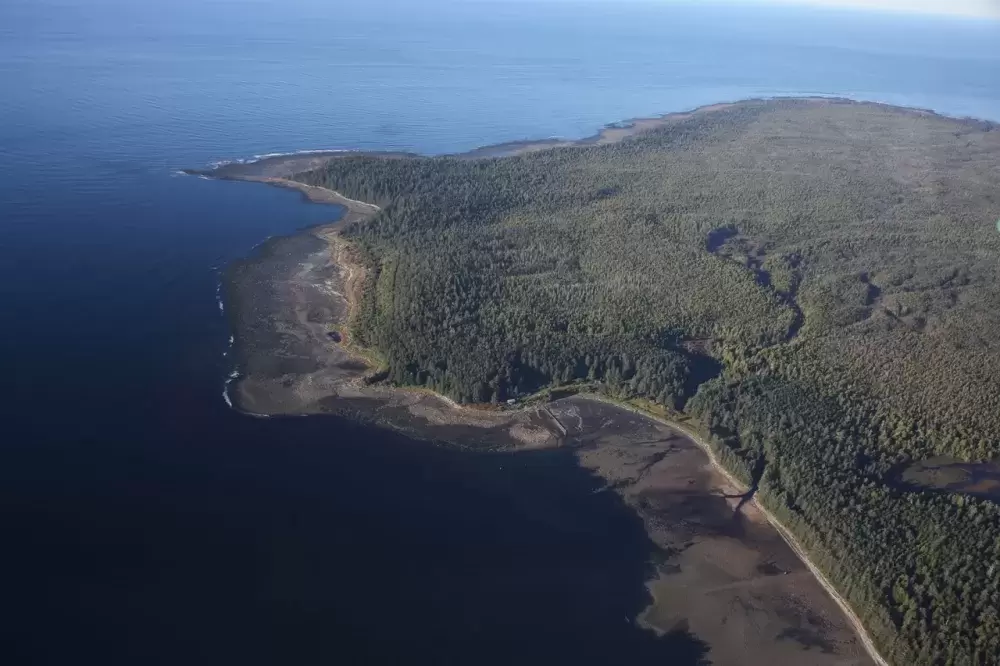Synthetic debris is present on every inch of Vancouver Island’s coast, making plastic pollution one of the factors in the decline of West Coast salmon stocks, says an organizer leading ongoing habitat revitalisation efforts in the region.
For the last two years Captain Josh Temple has helped to coordinate large-scale cleanup projects on the west coast of Vancouver Island. With the founding of Clayoquot CleanUp, a team of 75 volunteers gathered 56 tonnes of debris from Hesquiaht Harbour in June 2017, a collection largely composed of pieces of plastic and Styrofoam that washed up on the shore of the First Nation’s ancestral home.
That same year Temple co-founded the Coastal Restoration Society, an organization that employs people from coastal communities to remediate wildlife habitat, respond to oil spills, mitigate petroleum pollution and deconstruct fish farms. Their work last year included targeting plastics on Flores Island’s Rafael Point, which is a breeding ground for orca, grey and humpback whales, as well as a cleanup of the Cleland Island Ecological Reserve west of Vargas Island, in advance of the expected bird migration. After these summer projects in Ahousaht territory, the CRS took part in gathering discarded vehicles, appliances and other debris from the First Nation’s community at the end of 2018.
In 2019 the society plans to rehabilitate 300-kilometres worth of shoreline, estuaries and intertidal zones in Clayoquot Sound to improve migratory salmon routes. For years the fish have literally swallowed the effects of synthetic debris that continually end up in the ocean.
“This is a phenomenon that we’ve really seen grow exponentially in the last 15-20 years, and it’s contributed to an accelerated decline of wild and hatchery salmonids,” said Temple, who is also a commercial and recreational fisherman. “They’re actually starving to death because they’re eating so much of these synthetic pollutants that it’s clogging up their entire digestive tract.”
A scientific study released in 2015 determined that even smaller creatures are consuming tiny pieces of plastic on the West Coast. Researchers Jean-Pierre Desforges, Moira Galbraith and Peter Ross found there to be up to 9,000 plastic particles per cubic metre of water off B.C.’s coast. Measuring under one millimetre in size, these microplastics are being ingested by the plankton at the base of the food chain.
“[S]pecies at lower trophic levels of the marine food web are mistaking plastic for food, which raises fundamental questions about potential risks to higher trophic level species,” stated the study. “One concern is risk to salmon: We estimate that consumption of microplastic-containing zooplankton will lead to the ingestion of two to seven microplastic particles per day by individual juvenile salmon in coastal British Columbia, and [as much as] 91 microplastic particles per day in returning adults.”
These tiny particles are the result of larger debris breaking down when it hits the shore, said Temple.
“When this stuff makes its way to the shorelines, the intertidal zone is where it encounters the logs and the rocks and really starts to break down at a very, very accelerated rate,” he said, adding that the key to future coastal revitalization efforts will be removing larger pieces. “The areas that we’ve done just this summer - or certainly last summer - have been inundated with new pollutants. So one of the things that we really have to do is to set up maintenance programs so that we have the dedicated annual funding to go into these places and ensure that they’re cleaned up every single year.”
Hesquiaht Harbour, the site of Clayoquot CleanUp’s first large-scale effort in 2017, serves as a deposit for the North Pacific’s debris. As one of the ancient site’s handful of residents, Dianne Ignace continues to see plastics collect from across the ocean since the cleanup a year and a half ago.
“They could probably fill up another barge,” she said while looking out onto the beach on a stormy day in January. “A lot more floats and little stuff. A lot of plastic; there’s a few crates and a few tote lids that we can see from the window.”
“Debris from Canadian sources is a fraction of the problem” said Temple of what his organizations have collected. “What we’re encountering mostly is pollution from international sources. And because of their poor practices with recycling and how they process their own domestic waste in regions like Asia, Russia, China, Indonesia, Korea, Japan, we are finding the lion’s share is derived from international sources.”
Clayoquot CleanUp and the Coastal Restoration Society have so far relied on private and corporate donations. Applications to the federal government’s EcoAction Community Funding Program and the Coastal Restoration Fund have been rejected, but Temple remains “cautiously optimistic” that support from Ottawa could come after the House of Commons unanimously passed an ocean plastics bill in December. Put forth by Courtenay-Alberni MP Gord Johns, M-151 calls for a “national framework for the reduction and eventual elimination of plastic pollution in aquatic environments,” stated a release from the federal NDP.
Captain Josh Temple will be speaking about his organization’s work on Friday, Jan. 18, 7-9 p.m. at the Campbell River Museum (470 Island Highway). The event is being hosted by Cermaq, an aquaculture company that has partnered with Clayoquot CleanUp and the Coastal Restoration Society, including recently investing over $250,000 into revitalization work in Ahousaht territory.







